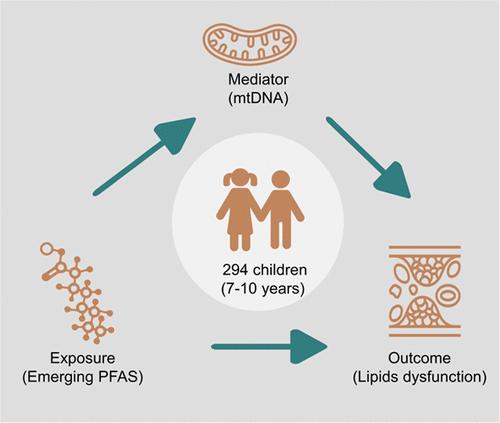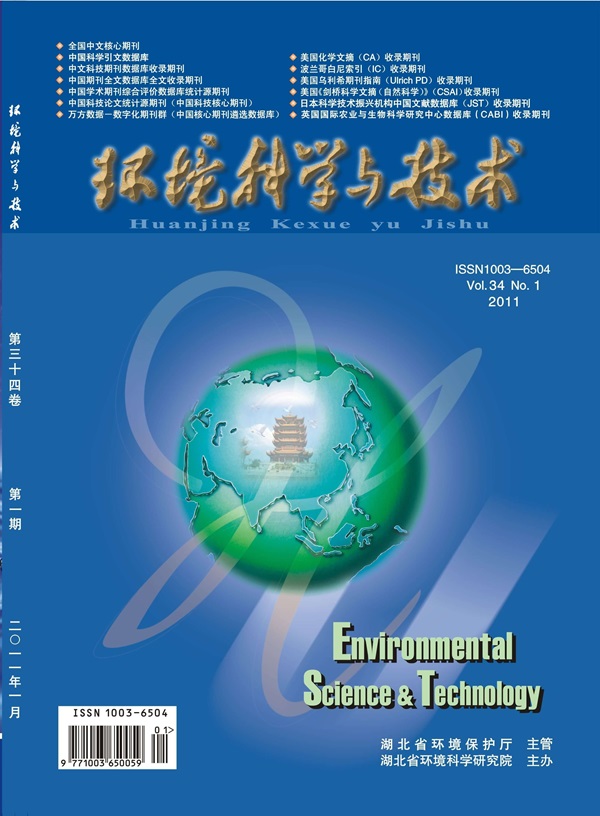Emerging PFAS Exposure Is More Potent in Altering Childhood Lipid Levels Mediated by Mitochondrial DNA Copy Number
IF 11.3
1区 环境科学与生态学
Q1 ENGINEERING, ENVIRONMENTAL
引用次数: 0
Abstract
Per- and polyfluoroalkyl substances (PFAS) pose potential health risks to lipid metabolism, but the effects of emerging PFAS alternatives, particularly in children, remain unclear. This cross-sectional study investigated the association between emerging PFAS exposure and lipid levels in 294 Chinese children aged 7–10 years, analyzing blood samples for 14 PFAS and lipid profiles, including triglycerides (TG), total cholesterol (TC), high-density lipoprotein (HDL), low-density lipoprotein (LDL), apolipoprotein A1 (ApoA1), and apolipoprotein B (ApoB). Exposure to 6:2 Cl-PFESA, PFO4DA, and PFO5DoDA was associated with higher TC, TG, and LDL levels, with PFO4DA increasing the TC by 1.7% and PFO5DoDA increasing the TG by 10.7%. Weighted quantile sum (WQS) regression showed mixed PFAS exposure positively associated with TG (0.08, 95% CI: 0.007, 0.153). PFO4DA had the highest weight for TC (0.468), TG (0.327), LDL (0.57), ApoA1 (0.243), and ApoB (0.466), while PFMOAA had the highest weight for HDL (0.332). Bayesian Kernel Machine Regression (BKMR) analysis confirmed positive associations between the PFAS mixture and TC, TG, LDL, and ApoA1. Mediation analysis revealed that mtDNAcn significantly mediated PFAS exposure’s effect on TG levels, explaining 27.2–74.2% of the total effect. These findings highlight the need for regulatory action to address the emerging PFAS risks.

新出现的PFAS暴露在线粒体DNA拷贝数介导的儿童脂质水平改变中更有效
全氟烷基和多氟烷基物质(PFAS)对脂质代谢构成潜在的健康风险,但新出现的PFAS替代品,特别是对儿童的影响尚不清楚。这项横断面研究调查了294名7-10岁中国儿童新出现的PFAS暴露与脂质水平之间的关系,分析了14种PFAS和脂质谱的血液样本,包括甘油三酯(TG)、总胆固醇(TC)、高密度脂蛋白(HDL)、低密度脂蛋白(LDL)、载脂蛋白A1 (ApoA1)和载脂蛋白B (ApoB)。暴露于6:2 cl - pfea, PFO4DA和PFO5DoDA与较高的TC, TG和LDL水平相关,PFO4DA使TC增加1.7%,PFO5DoDA使TG增加10.7%。加权分位数和(WQS)回归显示混合PFAS暴露与TG呈正相关(0.08,95% CI: 0.007, 0.153)。PFO4DA对TC(0.468)、TG(0.327)、LDL(0.57)、ApoA1(0.243)、ApoB(0.466)的检测质量最高,PFMOAA对HDL的检测质量最高(0.332)。贝叶斯核机回归(BKMR)分析证实PFAS混合物与TC、TG、LDL和ApoA1呈正相关。中介分析显示mtDNAcn显著介导PFAS暴露对TG水平的影响,解释总效应的27.2-74.2%。这些发现强调了采取监管行动解决新出现的PFAS风险的必要性。
本文章由计算机程序翻译,如有差异,请以英文原文为准。
求助全文
约1分钟内获得全文
求助全文
来源期刊

环境科学与技术
环境科学-工程:环境
CiteScore
17.50
自引率
9.60%
发文量
12359
审稿时长
2.8 months
期刊介绍:
Environmental Science & Technology (ES&T) is a co-sponsored academic and technical magazine by the Hubei Provincial Environmental Protection Bureau and the Hubei Provincial Academy of Environmental Sciences.
Environmental Science & Technology (ES&T) holds the status of Chinese core journals, scientific papers source journals of China, Chinese Science Citation Database source journals, and Chinese Academic Journal Comprehensive Evaluation Database source journals. This publication focuses on the academic field of environmental protection, featuring articles related to environmental protection and technical advancements.
 求助内容:
求助内容: 应助结果提醒方式:
应助结果提醒方式:


